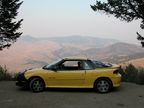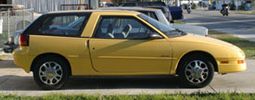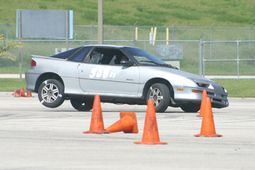The History Of Isuzu PA NERO

The Geo Storm was a sport compact car manufactured by Isuzu and sold in the United States by General Motors from 1990 through 1993 as part of GM's Geo line of inexpensive automobiles. The same vehicles, with minor variations, were sold in Canada in the 1992 & 1993 model years only. The Storm was intended to be a budget car with the look and feel of a sports car. It replaced the related Geo Spectrum, which was sold in hatchback and sedan, and like its predecessor, it is only sold in 2-door hatchback and station wagon.
The Geo Storm was a rebadged version of the sporty Isuzu Impulse minus some of that car's more expensive features. The Storm and the Impulse were sold in Japan as the PA-Nero and related Gemini Coupe. The Storm lacked the Impulse's Lotus-tuned suspension as well as the Impulse's optional turbocharger and all-wheel drive drivetrain. Although they were essentially the same car, sales of the Storm were much stronger than those of the Impulse—indeed, the Storm sold better than most small GM cars of that era. Slow sales of the Isuzu version doomed the Storm as when the Isuzu Impulse was canceled, the Geo Storm derivative had nothing to be built from, meaning both cars were discontinued in 1993.
The Storm was manufactured at Isuzu's main plant in Fujisawa, Kanagawa, Japan. The Storm and Impulse was sold in Canada by GM as the Asüna Sunfire.
The most common body style for the Storm was a three-door hatchback. The 1990 and 1991 hatchbacks were produced in two trim packages, but all Storms shared front disk and rear drum brakes and had an anti-sway bar to tighten the front suspension. The base model was priced at $10,390, and the GSi was $11,650.USD
The base model's SOHC engine produced 95hp (71kW) and had a 9.1:1 compression ratio. The more powerful 1990-1991 GSi used a 1.6L DOHC engine that produced 130hp (97kW) and had a 9.8:1 compression ratio.. The GSi package also included driving lights, a spoiler, a rear anti-sway bar, and a transmission with a gear ratio that was slightly better for acceleration than the base model's transmission.
For 1991 and 1992, customers had the option of purchasing a two-door station wagon body style, also called a wagonback. The base price of the station wagon was $11,450, and it was never offered with the stronger GSi engine. Oddly, the station wagon was marketed as a "hatchback" and the normal Storm - an actual hatchback - was marketed as a "coupé".
In 1992, the Storm was restyled to have a smoother front fascia without the pop-up headlight covers on earlier models. The 1992–93 base models retained the same engine, features, and price that were on the earlier car, with slight interior changes such as different stereos, revised rear speaker locations, and interior trim and upholstery. The GSi version from these years cost considerably more ($13,645–14,560) but this price included a larger 1.8L 140hp (104kW) engine.
Modern sport compacts have faster acceleration and better handling, but the performance figures for the Storm were quite respectable for an economical compact car from that era. AutoWeek's 1990 review of the storm was titled "Slick, Quick And Inexpensive", and described the car as "a good performer" that "handles better than the average new car." When Road & Track compared ten sport compact cars they said the Storm had "the highest skidpad rating (0.85 g), sticks like pine tar to the autocross course, is second-quickest through the slalom and stops shorter from 80mph (130km/ h) than many highly respected sports cars".
Skid pad test figures ranged from 0.81g to 0.85g, meeting or exceeding those of the Mazda RX-7 convertible. Sport Compact Car listed the Storm as number three in their "Top Ten of 1992". Hot Rod Magazine's Jeff Smith drove a Geo Storm that was set up for SCCA Super Production racing and declared it to be "every bit as demanding and fun" as racing a Trans-Am series car.
Two different Geo Storm Celebrity Races were held in 1991, the first on July 13 in Des Moines, Iowa, and the second on August 24 in Denver, Colorado. Although they are not the most common type of race cars, modified Storms are still occasionally used to compete in road racing, drag racing and autocross. One of the 2003 entries in the Grassroots Motorsports Challenge was a Storm GSi.
The Storm sold well and was popular with owners, despite getting mixed reviews from automotive magazines. The body styling was "mildly controversial". Kevin Smith of Car and Driver used phrases like "Planet Zarkon" and "space-capsulish" to describe the body, which he listed as one of the best and worst features of the Storm. AutoWeek said that college-aged people tended to "shower the Storm with attention", but that baby boomers tended to "think that at best, the Storm is unusual looking, at worst, odd."
The shape of the body was not the only thing automotive journalists criticized. The engine was described as a "buzzbomb" or "just plain noisy". A few reviewers disliked the suspension, saying the Storm has "above average body lean and needs more rebound control". Some complained about the small cargo area, visibility and the absence of headroom for backseat passengers.
Other aspects of the Storm were more popular with magazine test drivers. Many praised the wide power band of the engine. AutoWeek said, "It revs quickly and easily. Running up to the 7600rpm redline can be a delight." Automobile Magazine liked the handling, saying, "It's a delight to negotiate twisty...roads with its firm yet compliant suspension."
It has been over a decade since Geo Storms were produced, but they can still be found in the used car market where their primary selling points tend to be low cost and reliability, features that make them ideal cars for student commuters. Hot Rod magazine's Jeff Smith said, "The Storm is also exceptionally durable and easy to maintain."
1991: A "hatchback" (station wagon/ wagonback) model was added, other than that, the Storm carried on unchanged. 1992: All three models of the Storm got a new headlight cluster, tail light, and front clip. The GSI version also got a new spoiler and a larger DOHC engine which offered 10 extrahp. 1993: The wagonback was dropped, and thehp rating of the base model dropped from 95 to 90 which would be the Storm's final season.Overall, there were six versions of the storm; the GSi, station wagon and base models were all produced with both the original flip-up lights design and with the smoother look of the 1992-1993 model years .
From Wikipedia, the free encyclopedia
More About Isuzu PA NERO



|